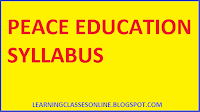PEACE
EDUCATION B.ED SYLLABUS

After completion of the course, student
teachers will be able to
·
understand
the theory of peace education and its importance
·
understand
peace as a dynamic social reality
·
understand
the NCF 2009 recommendations on peace education
·
familiarize
with transactional modalities
·
develop the
skill in role-playing & storytelling
·
develop the
feelings of peace, love compassion, tolerance and harmony through
·
meditation,
yoga and exercise
·
implement
the philosophies of great thinkers in their day to day life
COURSE CONTENTS (SYLLABUS)
UNIT -1
Peace: Concept and Scope:
·
Peace –
Meaning, nature and its relevance relating to the present global scenario
·
Different
sources of peace: Philosophical, Religious, Social and Psychological.
·
Types/Classification
of peace- Positive, Negative, Inner peace, Social Peace and Peace with Nature.
·
Peace
Education: concept and scope
·
Peace
education – fundamental concept, scope, need and its importance
·
Aims of
Peace Education
·
Types of
peace education
Peace Education: Strategies and Agencies:
·
Different
Peace Education Strategies.
·
Role of
different organizations like UNESCO in
Peace Education (
with special reference to Delor’s Commission Report)
·
NCF 2009
recommendations on Peace Education.
·
Role of
community, school, and family in the development of values for
Peaceful coexistence
UNIT-2
Understanding Peace as a Dynamic Social
Reality:
·
Challenges
to peace by increasing stresses, conflicts, crimes, terrorism, violence and
wars resulting in the poor quality of life.
·
Role of
Peace education in the development of Love, Compassion, Tolerance, and Harmony at
National and International levels.
·
Transactional
modalities
·
Cooperative Learning
·
Group Discussion
·
Project Work
·
Conflict
Resolution
·
Contribution
of the following Great Educational Thinkers in Peace Education and their
Educational Implications
·
Rabindranath Tagore
·
Mahatma
Gandhi
·
Aurbindo
·
Swami
Vivekananda
Tasks & Assignments: Any one of the following
·
Role-Playing
& Story Telling
·
Peace and
Harmony Through Meditation, Yoga, And Exercise
·
Any other
project/assignment given by the institution.
SUGGESTED READINGS AND BOOKS FOR PEACE EDUCATION
·
Balvinder K.
(2006).Peace Education. New Trends and Innovations, Deep & Deep
Publications Pvt. Ltd., Rajouri Garden, New Delhi.
·
Bernard,
H.W. (1951). Towards Personality Adjustment, Mc Graw Hill Book Co., New York.
·
Biggs,
D.(1995). In Our Own Backyard: A teaching guide for the rights of the child,
Toronto: UNICEF Canada.
·
Blakeway, M., (1997). Compilation of Research Materials.
Washington D.C., National Institute for Dispute Resolution.
·
Blalock, H.
M. (1967).Toward a Theory of Minority-Group Relations.
New York: Wiley.
·
Boulding, E.
(1996). Peace behaviors in various societies. In
From a culture
of violence to a culture of peace, Peace and Conflict Issues Series, UNESCO
Publishing, pp 31– 54.
·
Dewey
(1969). The school and Society, Chicago, Univ. of Chicago Press (Reprint).
·
Lederach, J.
P.(1995). Preparing for peace: conflict transformation across cultures. Syracuse, New York: Syracuse
University Press.
·
Machel, G. (1996). Promotion and protection of
the rights of children: impact of armed conflict on children. United Nations,
New York.
·
Reardon, B., ed. (1988). Educating for global
responsibility: Teacher-designed curricula for peace education, K-12. New York:
Teachers College Press, Columbia University.
·
Reardon, B.(1993). Pedagogy as purpose: peace
education in the context of violence. In Cremin, P., ed. (1993). Education for
Peace. Educational Studies Association of Ireland and the Irish Peace Institute.
·
Shah, I. (1971). Thinkers of the East. London:
Penguin Books.
·
UNICEF(1994). I Dream of Peace. New York: Harper-Collins.
·
UNICEF (1996). The State of the World’s Children
Report 1996. Oxford
University Press.
·
UNICEF Lebanon (1993). ‘Learning for life program’.
·
UNICEF Liberia (1993). Kukatonon: Training manual of conflict resolution, reconciliation, and peace.
Similar Posts
- Reading and reflecting on texts syllabus
- PEDAGOGY OF SANSKRIT SYLLABUS
- PEDAGOGY /TEACHING OF HINDI SYLLABUS
- PEDAGOGY OF ENGLISH B.ED SYLLABUS
- Jean Piaget Theory of Cognitive Development
- Stages of Growth and Development: From Infancy to Adolescence
- Reading for Global and Local Comprehension: Enhancing Understanding at All Levels
- The Acquisition of Reading Skills: Strategies and Techniques for Effective Learning
- The Concept of Growth and Development: Understanding Their Meaning and Significance
- (10) Principles of Growth and Development: Understanding Child Development
- What Is Hearing Impairment ?: Meaning, Definition, Causes, Types and Characteristics
- Continuous And Comprehensive Evaluation (CCE) Notes
- Pedagogy of English Lesson Plan Format for B.Ed and Teachers
- Art Lesson Plan in Hindi | कला शिक्षा पाठ योजना
- B.Ed Syllabus
- WORK EDUCATION SYLLABUS
- UNDERSTANDING THE SELF SYLLABUS
- UNDERSTANDING DISCIPLINES AND SUBJECTS SYLLABUS
- SKILL IN TEACHING SYLLABUS
- SCHOOL BASED ACTIVITIES SYLLABUS
💁Hello Friends, If You Want To Contribute To Help Other Students To Find All The Stuff At A Single Place, So Feel Free To Send Us Your Notes, Assignments, Study Material, Files, Lesson Plan, Paper, PDF Or PPT Etc. - 👉 Upload Here
अगर आप हमारे पाठकों और अन्य छात्रों की मदद करना चाहते हैं। तो बेझिझक अपने नोट्स, असाइनमेंट, अध्ययन सामग्री, फाइलें, पाठ योजना, पेपर, पीडीएफ या पीपीटी आदि हमें भेज सकते है| -👉Share Now
If You Like This Article, Then Please Share It With Your Friends Also.
Bcoz Sharing Is Caring😃
For the Latest Updates and More Stuff... Join Our Telegram Channel...


Post a Comment
Please Share your views and suggestions in the comment box